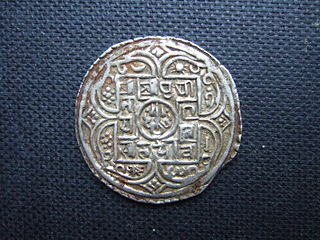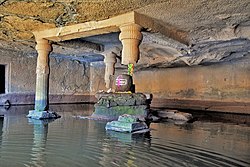The wheel of time or wheel of history is a concept found in several religious traditions and philosophies, notably religions of Indian origin such as Hinduism, Jainism, Sikhism, and Buddhism, which regard time as cyclical and consisting of repeating ages. Many other cultures contain belief in a similar concept: notably, the Q'ero Natives of Peru, as well as the Hopi Natives of Arizona.
Kali Yuga, in Hinduism, is the fourth and worst of the four yugas in a Yuga Cycle, preceded by Dvapara Yuga and followed by the next cycle's Krita (Satya) Yuga. It is believed to be the present age, which is full of conflict and sin.
A yuga, in Hinduism, is generally used to indicate an age of time.
The 32nd century BC was a century that lasted from the year 3200 BC to 3101 BC.
Itihasa refers to the collection of written descriptions of important events in Hinduism. It includes the Mahabharata, the Puranas and the Ramayana. The Mahabharata includes the story of the Kurukshetra War and preserves the traditions of the Lunar dynasty in the form of embedded tales. The Puranas narrate universal history – the books discuss in depth the topics of cosmogony, myth, legend and history. The Ramayana contains the story of Rama and is incidentally related to the legends of the Solar dynasty. A story is considered to be itihasa only when the author of the story has himself witnessed or is part of the story. Vyasa, who wrote the Mahabharata, is himself a character in the story. Similarly, Valmiki, who wrote the Ramayana, was also a character in the story. Many classical Indian poets derive the plots of their poetry and drama from the Itihasa. The tradition of itihāsa is generally understood to be developed by the bardic tradition of Sūtas and Cāraṇas whose duties consisted of composing royal eulogies.

The Indian national calendar, sometimes called the Shaka calendar or Śaka calendar, is a solar calendar that is used alongside the Gregorian calendar by The Gazette of India, in news broadcasts by All India Radio, and in calendars and official communications issued by the Government of India. Śaka Samvat is generally 78 years behind the Gregorian Calendar, except from January to March, when it is behind by 79 years.

Treta Yuga, in Hinduism, is the second and second best of the four yugas in a Yuga Cycle, preceded by Krita (Satya) Yuga and followed by Dvapara Yuga. Treta Yuga lasts for 1,296,000 years.
Hindu eschatology is linked in the Hindu tradition to the figure of Kalki, or the tenth and last avatar of Vishnu names of the Supreme Being in Hinduism and before the age draws to a close, and Harihara simultaneously dissolves and regenerates the universe.

Dvapara Yuga, in Hinduism, is the third and third best of the four yugas in a Yuga Cycle, preceded by Treta Yuga and followed by Kali Yuga. Dvapara Yuga lasts for 864,000 years.
Hindu cosmology is the description of the universe and its states of matter, cycles within time, physical structure, and effects on living entities according to Hindu texts. Hindu cosmology is also intertwined with the idea of a creator who allows the world to exist and take shape.

The Saptarshi are the seven Brahmins of ancient India who are extolled in the Vedas, and other Hindu literature such as the "Skanda Purana". The Vedic Samhitas never enumerate these rishis by name, although later Vedic texts such as the Brahmanas and Upanisads do so.

Pralaya is a concept in Hindu eschatology. Generally referring to four different phenomena, it is most commonly used to indicate the event of the dissolution of the entire universe that follows a kalpa called the Brahmapralaya.
A kalpa is a long period of time (aeon) in Hindu and Buddhist cosmology, generally between the creation and recreation of a world or universe.
A manvantara, in Hindu cosmology, is a cyclic period of time identifying the duration, reign, or age of a Manu, the progenitor of mankind. In each manvantara, seven Rishis, certain deities, an Indra, a Manu, and kings are created and perish. Each manvantara is distinguished by the Manu who rules/reigns over it, of which we are currently in the seventh manvantara of fourteen, which is ruled by Vaivasvata Manu.
Hindu units of time are described in Hindu texts ranging from microseconds to trillions of years, including cycles of cosmic time that repeat general events in Hindu cosmology. Time is described as eternal. Various fragments of time are described in the Vedas, Manusmriti, Bhagavata Purana, Vishnu Purana, Mahabharata, Surya Siddhanta etc.
In India, the Teluguyear is the calendar year for the Telugu speaking people of Andhra Pradesh & Telangana states and Yanam.

The Puranic chronology is a timeline of Hindu mythology based on the Mahabharata, the Ramayana, and the Puranas. The central dates here are the Kurukshetra War and the Lanka War with the start of the start and end of the Kali Yuga and the other yugas and all the other events in Hindu mythology. The Puranic chronology is referred to by proponents of Indigenous Aryans to propose an earlier dating of the Vedic period, and the spread of Indo-European languages out of India, arguing that "the Indian civilization must be viewed as an unbroken tradition that goes back to the earliest period of the Sindhu-Sarasvati Valley traditions ."
Vyasaa.k.a.Veda Vyāsa is the title given to the Rishi (sage) who comes at the end of every Dvapara Yuga to divide and compile the one Veda into four and compile the Puranas and Mahabharata for the benefit of mankind in the degraded age that follows, Kali Yuga. Vyasa is a central and revered figure in most Hindu traditions. In the 28th mahayuga (current), Krishna Dvaipāyana Vyasa was Vyasa, whose name refers to his complexion and birthplace, and who is believed to be a partial incarnation of Vishnu that occurs once in every kalpa. In the upcoming 29th mahayuga, Guru Drona's son Rishi Aswatthama will be born as the next Vyasa. In the previous 27th mahayuga, Veda Vyasa's father was Vyasa.
A Yuga Cycle is a cyclic age (epoch) in Hindu cosmology. Each cycle lasts for 4,320,000 years and repeats four yugas : Krita (Satya) Yuga, Treta Yuga, Dvapara Yuga, and Kali Yuga.







